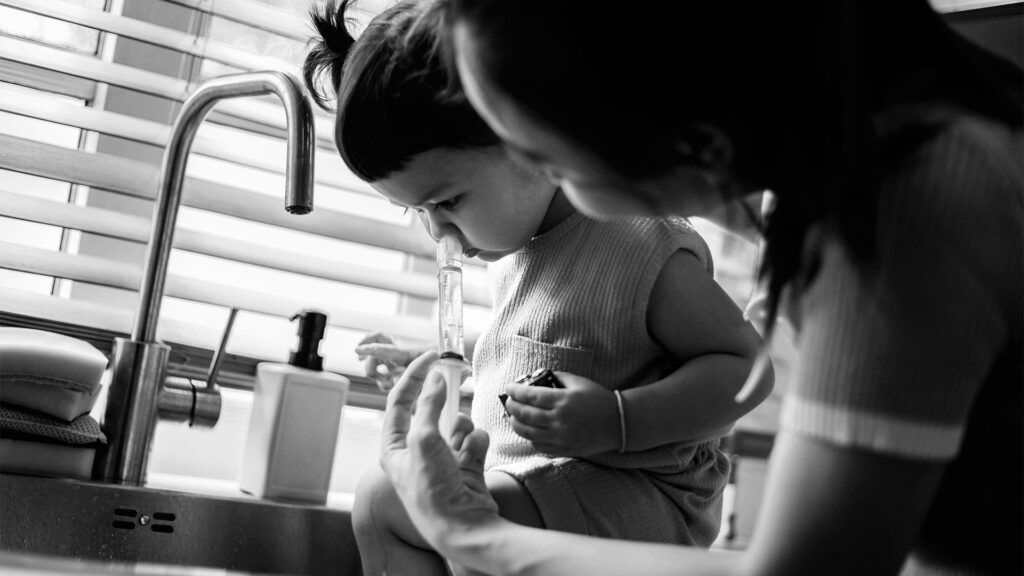People can make saline solution at home by mixing together certain amounts of salt and water. However, it is essential to follow the guidelines regarding quantities and hygiene.
When prepared correctly, homemade saline solution is similar to distilled water. For this reason, it is safe to use in the nose as a sinus rinse and as an eye rinse. A person can also use saline solution to rinse contact lenses, piercings, and cuts or scrapes, but this will not sterilize them.
In this article, we discuss how to make 0.9 percent saline solution, its uses, and how to store it.

Homemade saline solution requires the following:
- 4 cups of distilled or boiled (for at least 20 minutes) water
- 2 teaspoons (tsp) of noniodized salt
- an airtight storage container with a lid, such as a bottle
- a mixing utensil
To make a smaller batch, use 1 cup of water with one-half tsp of salt.
If using tap water, boil it first for at least 20 minutes to sterilize the water and remove any bacteria and chemicals. Let it cool before use.
To make saline solution at home, follow these steps:
- wash the hands thoroughly
- sterilize the container and mixing utensil by using a dishwasher or boiling them in water
- pour the water into the container
- mix in the salt and stir until completely dissolved
- let the mixture cool before use
Store the saline solution in the airtight container.
Saline solution for sinus irrigation
To make a sinus rinse, or nasal irrigation solution, follow these steps:
- mix together 3 tsp of salt and 1 tsp of baking soda
- add 1 tsp of this mixture into 1 cup of water and stir until the solids have dissolved
Using a neti pot, ear bulb, or saline rinse bottle, squeeze the solution into the right then the left nostril. Keep the head over a sink or bath, as the solution will come out of the nostrils.
People can find ear bulbs at drug stores and online. Neti pots are also available at drug stores and online.
It is important to try to prevent any bacteria or other contaminants from entering the solution when making homemade saline.
The following tips will help prevent saline solution from becoming contaminated:
- only use clean materials to make the saline solution
- avoid touching the solution with the fingers or hands
- use a thoroughly clean bottle for each new batch of saline solution
- use clean, dry droppers and rinse bottles when using the solution for irrigation
Despite a person’s best efforts, contaminants can still affect the solution. Dispose of the solution if it looks cloudy or dirty.
Saline solution is salt water that contains 0.9 percent salt. It has a similar salt and water composition as a person’s blood and tears. As a result, it makes a useful irrigating solution.
Saline solution has many home uses, including:
- Clearing the sinuses. People can irrigate their nasal passages with saline solution to relieve the symptoms of sinusitis, colds, and allergies. Nasal irrigation moisturizes the nose and removes excess mucus and bacteria.
- Soothing the throat. A salt water gargle can help relieve a sore throat.
- Cleaning wounds. Saline can clean cuts and scrapes. Wound irrigation also removes dead skin cells and debris.
- Bladder irrigation. People with a catheter can use saline solution to irrigate the bladder.
- Rinsing contact lenses and piercings. Soaking contact lenses, piercings, and other objects in saline solution can help keep them free from bacteria.
The small amount of salt present can have an antibacterial effect. This is one of the reasons why foods preserved with salt tend to spoil less quickly than foods without salt.
While salt can sting on an open wound, the low concentration of salt in a saline solution means that it should not sting or burn. If the solution does sting, the mixture may contain too much salt. Do not use iodized salt when making saline solution.
Avoid using saline solution that is too hot, as it may burn the delicate skin inside the nasal passage, around the eyes, or around wounds.
For the best results, try to use saline solution before applying medications such as eye drops or inhaled mists, as the solution could wash these away.
Side effects are uncommon when people use saline solution correctly. Making an effort to keep containers clean and free of bacteria can help, as can always washing the hands before using the solution.
People can make saline solution at home using noniodized salt and water. For a sinus rinse, they can also add baking soda.
People can use homemade saline solution to rinse the sinuses, make a salt water gargle, clean wounds, and rinse contact lenses, piercings, or both.
People may wish to talk to a doctor before using saline solution in wounds, sinus passages, or the bladder to ensure that they are doing so safely.
If the solution comes into contact with something that a person has not sterilized or seems contaminated, dispose of the batch immediately.
